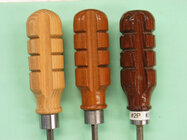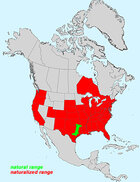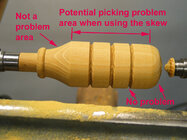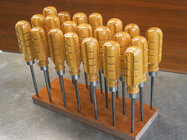Can anybody suggest a reasonable source? I have never used it, but would like to try it.
-
December 2025 Turning Challenge: Single Tree! (click here for details) -
Congratulations to Bob Henrickson, People's Choice in the November 2025 Turning Challenge (click here for details) -
Congratulations to John Dillon for "Chinquapin Oak" being selected as Turning of the Week for December 22, 2025 (click here for details) -
Welcome new registering member. Your username must be your real First and Last name (for example: John Doe). "Screen names" and "handles" are not allowed and your registration will be deleted if you don't use your real name. Also, do not use all caps nor all lower case.
You are using an out of date browser. It may not display this or other websites correctly.
You should upgrade or use an alternative browser.
You should upgrade or use an alternative browser.
Osage Orange source?
- Thread starter Tom Albrecht
- Start date
- Joined
- Jul 18, 2018
- Messages
- 1,351
- Likes
- 2,930
- Location
- Baltimore, MD
- Website
- loujacobswoodturning.com
It has a pretty wide range over the USA, including, according to the maps I just looked at, all of your state. Why not get in touch with a couple of local arborists and see if they are cutting any of it in your area.
Name used varies depending on geographic locations
- Joined
- Apr 27, 2004
- Messages
- 9,308
- Likes
- 6,080
- Location
- Lakeland, Florida
- Website
- www.hockenberywoodturning.com
It has a pretty wide range over the USA, including, according to the maps I just looked at, all of your state. Why not get in touch with a couple of local arborists and see if they are cutting any of it in your area.
Name used varies depending on geographic locations
It’s quite wide spread now.
Osage Orange was unknown east of the Mississippi when Lewis and Clark set out to find out how big the Louisiana purchase was.
A great book Undaunted Courage by Ambrose talks about Lewis and Clark introducing the Osage Orange to science.
They named it the Osage Apple and Jefferson planted trees from cutting they sent him.
It was widely planted as a living fence. Few cows wanted to test its two inch thorns. Hence the “Hedge Apple” common name.
Also there is some speculation that native Americans may have increased it distribution.
Bodark is another common name in Louisiana and Texas derived from the way those folks chose to spell “bois de l'arc” (wood of the bow) the French colonial name.
I'll have some in my booth at Turn On Chicago in August, or if you want to drive to Peoria after the show. If I still have any.
QUOTE="Bob Brown, post: 245971, member: 1715"]
Name used varies depending on geographic locations
It’s quite wide spread now.
Osage Orange was unknown east of the Mississippi when Lewis and Clark set out to find out how big the Louisiana purchase was.
A great book Undaunted Courage by Ambrose talks about Lewis and Clark introducing the Osage Orange to science.
They named it the Osage Apple and Jefferson planted the trees from cutting they sent him.
It was widely planted as a living fence. Few cows wanted to test its two inch thorns. Hence the “Hedge Apple” common name.
Also there is some speculation that native Americans may have increased it distribution.
Bodark is another common name in Louisiana and Texas is the way those folks chose to spell “bois de l'arc” the French colonial name.
[/QUOTE]
My family were tenant farmers around Hartsburg/Emden IL. We never owned an inch of farm ground. An Irish man named William Scully came through starting in 1850 and bought over 28,000 acres of farmland in Logan County. He supported farmers to plant Osage (hedge rows). My Dad planted rows himself, thinking he would be growing his own fence posts. In a couple of decades he laughed about his folly after seeing how slow they grow!! https://www.logancoil-genhist.org/LogCoSpots/Scully/Scullyfamily.htm
I've used this supplier for bowl and spindle Osage blanks many times: https://www.gvwp.net/product.php?slug=bowl-blanks
Attachments
My wood supplier here in Ontario has 2 large logs and access to more. But getting them across the border might be an issue.
Osage is a lot like Mesquite in the fact that it's an extremely rare thing to find good clear blanks.
If you are ever in the Nashville area, I can hook you up. I have OO laying on the ground that has been there for years (decades, maybe). It's still as sound as the day it hit the ground.
See you there.I'll have some in my booth at Turn On Chicago in August, or if you want to drive to Peoria after the show. If I still have any.
Osage is native to N Texas and S Oklahoma. It now grows around the world. I had a friend that was in Yugoslavia and saw some down town in a city that were 30 inch diameter. It spread a lot during the Great Depression for wind breaks. It was also planted along the wagon train routes because it made excellent wheel spokes. The wood can be used for dying fabric. The old farmers would say that a black locust fence post would wear out one fence post hole, and an Osage orange one would wear out 2 fence post holes. It is similar to the locust wood in hardness. There is a long line of them in the foot hills just north of me that were supposed to be planted by the wagon trains, so over 100 years old.
robo hippy
robo hippy
Here's the original native range of Osage orange. This comes from a book Atlas of United States Trees.
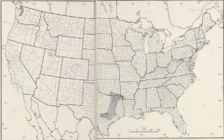

- Joined
- Jul 18, 2018
- Messages
- 1,351
- Likes
- 2,930
- Location
- Baltimore, MD
- Website
- loujacobswoodturning.com
PS: Osage doesn't like the skew chisel for smoothing. It has a tendency to pick and chip out.
Just out of curiosity, what would you pay per board foot for freshly sawn Osage in your area? My wood guy was trying to figure out a price because these are the first logs he has come across.
I have good luck with just my SRG on shafts. Plus it sands really easy. Most of these are hedge applePS: Osage doesn't like the skew chisel for smoothing. It has a tendency to pick and chip out.
Attachments
Freshly sawn is only a part of the defining parameters. Most important is grade. NHLA grade rules will help define the difference between firewood grade and clear wood suitable for wood turning.
Osage dries a little like the various oak species, so expect some end checking splits if the ends aren't sealed well after the wood has been sawn into usable lumber.
In log form, any wood is high risk
Osage dries a little like the various oak species, so expect some end checking splits if the ends aren't sealed well after the wood has been sawn into usable lumber.
In log form, any wood is high risk
I have good luck with just my SRG on shafts. Plus it sands really easy. Most of these are hedge apple
If by 'SRG' you mean spindle roughing gouge, then that's exactly what I've found also. I've tried other tool shapes, but the roughing gouge seems to be the best.
- Joined
- Feb 28, 2021
- Messages
- 1,777
- Likes
- 1,590
- Location
- Roulette, PA
- Website
- www.reallyruralwoodworks.com
As mentioned by Bob above - It would depend on the grade - Clear 4/4 Select or Better grades, might get 10 bucks a board foot, but "firewood" grade sawn flat you might be lucky to get a buck a board foot if that. I believe much of the more desirable turner's lumber (Apple, Hornbeam, Fruitwoods, etc.) does not get sawn into boards because simply the condition of the logs/trunk may be in, and the time and trouble to saw out the logs, may result in maybe a quarter of the log giving salable lumber, if that, and then it becomes unprofitable (Or prohibitively expensive) Apple tree, you might get a 6 or 8 foot usable trunk , but the problem is it likes to crack and check so fast, it'd be difficult to saw enough lumber to be commercially profitable. OTOH, a nice Oak tree of the same diameter, you might get 20 or 30 feet of lumber grade trunk which could be sawn into much more usable lumber, and thus much more profitable even being sold at a lower price.Just out of curiosity, what would you pay per board foot for freshly sawn Osage in your area? My wood guy was trying to figure out a price because these are the first logs he has come across.
That is not my experience, it's not any different that any hard wood where the grain goes in and out of the face.PS: Osage doesn't like the skew chisel for smoothing. It has a tendency to pick and chip out.
We have a good bit of it at our place in Grenada MS. Some are pretty large. Known here as Bowdock or Horse Apple. I’ve turned a limb piece that came off a few years ago. My experience, little as it is, is the same as Richards. By the way, the grapefruit size fruit from it makes great targets. They explode beautifully!
Tom , Check with Kramer tree service out of West Chicago.
Yep. I have just one live one on my property, but they are somewhat common around here.Kent, yes, that’s its original “native” range, but look where it is found now :
View attachment 65181
Freshly sawn is only a part of the defining parameters. Most important is grade. NHLA grade rules will help define the difference between firewood grade and clear wood suitable for wood turning.
Osage dries a little like the various oak species, so expect some end checking splits if the ends aren't sealed well after the wood has been sawn into usable lumber.
In log form, any wood is high risk
I literally stumbled across a couple of downed OO trees on my place. I have no idea how long they have been lying there. The stuff I cut from it is damn near perfect, still. From what I understand, some of the trunks tend to have a twist to them. No issue for turners, but it might not make the best flat sawn wood.
If it is the bright orange color that is attracting you, please know that over time it will turn to chocolate brown.
It’s quite wide spread now.
Osage Orange was unknown east of the Mississippi when Lewis and Clark set out to find out how big the Louisiana purchase was.
A great book Undaunted Courage by Ambrose talks about Lewis and Clark introducing the Osage Orange to science.
They named it the Osage Apple and Jefferson planted the trees from cutting they sent him.
It was widely planted as a living fence. Few cows wanted to test its two inch thorns. Hence the “Hedge Apple” common name.
Also there is some speculation that native Americans may have increased it distribution.
Bodark is another common name in Louisiana and Texas is the way those folks chose to spell “bois de l'arc” the French colonial name.
My family were tenant farmers around Hartsburg/Emden IL. We never owned an inch of farm ground. An Irish man named William Scully came through starting in 1850 and bought over 28,000 acres of farmland in Logan County. He supported farmers to plant Osage (hedge rows). My Dad planted rows himself, thinking he would be growing his own fence posts. In a couple of decades he laughed about his folly after seeing how slow they grow!!
https://www.logancoil-genhist.org/LogCoSpots/Scully/Scullyfamily.htm
in the south we call them Horse Apples although I don't know if horses actually ever eat them.
I was attempting to turn a box from a piece that was very cross grained rather than straight grain. Skew did fine on one side but ripped it up on the other side. Shear scraping cleaned up the torn side. For this box, I will have to use a collar for the tenon. My skills with a skew are not very up there......
robo hippy
robo hippy
That is interesting.Osage's color evolves over time from yellow to amber to dark amber like walnut.
Below screwdriver handles. On the left is new, in the middle, about five years old, and on the right, probably 15 years old or more.
View attachment 65180
I have and turned some Osage Orange, got it in southern Ontario where it does grow, though actually a rare tree and growing only closer to the lakes and not very far north at all.
I got interested in it when I saw those greenish balls along a country road, picked a couple up and inquired what this was, no one knew, until I talked to a buddy that lived but a stone throw from lake Erie and there were these trees growing on the family farm, got a stump from him that got cut down some 30 years before, as it was a leaner hanging over the field, turned that bowl and a couple other smaller pieces, the stump had splits in it, so had to choose carefully from this rare (for me) wood, turned really nice with a golden yellow color.
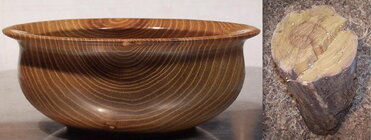
So then I was on the lookout for Osage Orange, found a few pieces that I turned, and saw the difference between Mulberry and Osage, look alike wood and related, but Mulberry did like to split more than the Osage wood and I found Osage turned nicer than Mulberry for me.
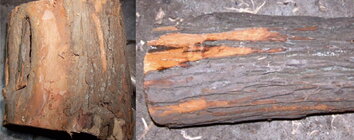
Quite stable when dry and one that showed this was a lidded pot I turned from it.
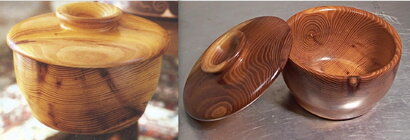
I was aware of the color change going from bright yellow if fresh wood, (the old stump did have different colors) but yes it does get quite dark after a time and continues for a long time, gets darker than the one shown.

Anyway it is a nice wood that turns just fine without any problems for me
I got interested in it when I saw those greenish balls along a country road, picked a couple up and inquired what this was, no one knew, until I talked to a buddy that lived but a stone throw from lake Erie and there were these trees growing on the family farm, got a stump from him that got cut down some 30 years before, as it was a leaner hanging over the field, turned that bowl and a couple other smaller pieces, the stump had splits in it, so had to choose carefully from this rare (for me) wood, turned really nice with a golden yellow color.

So then I was on the lookout for Osage Orange, found a few pieces that I turned, and saw the difference between Mulberry and Osage, look alike wood and related, but Mulberry did like to split more than the Osage wood and I found Osage turned nicer than Mulberry for me.

Quite stable when dry and one that showed this was a lidded pot I turned from it.

I was aware of the color change going from bright yellow if fresh wood, (the old stump did have different colors) but yes it does get quite dark after a time and continues for a long time, gets darker than the one shown.

Anyway it is a nice wood that turns just fine without any problems for me
Last edited:
- Joined
- Apr 27, 2004
- Messages
- 9,308
- Likes
- 6,080
- Location
- Lakeland, Florida
- Website
- www.hockenberywoodturning.com
You understand the issue is a fiber riding over the cutting edge because it is pointing up.Clearly I need to clarify the potential for picking. Crossgrain (bowls) turning isn't any more challenging than any other ring porous hard wood.
View attachment 65245
Figured wood, spindles slightly off axis are especially problematic.
I have a few tricks I use
First I slow the lathe speed. This often lets the fibers get cut before they get lifted.
A pull cut with the wing of an Ellsworth ground gouge often works well
A spindle gouge with a 30 degree bevel often works well
Roughing gouge should work too. I just grab the bowl gouge first for the pull cut.
Applying thin shellac sometimes helps too.
Hi Leo. My wood supplier here in southern Ontario has 2 large logs if you are interested.I have and turned some Osage Orange, got it in southern Ontario where it does grow, though actually a rare tree and growing only closer to the lakes and not very far north at all.
I got interested in it when I saw those greenish balls along a country road, picked a couple up and inquired what this was, no one knew, until I talked to a buddy that lived but a stone throw from lake Erie and there were these trees growing on the family farm, got a stump from him that got cut down some 30 years before, as it was a leaner hanging over the field, turned that bowl and a couple other smaller pieces, the stump had splits in it, so had to choose carefully from this rare (for me) wood, turned really nice with a golden yellow color.
View attachment 65231
So then I was on the lookout for Osage Orange, found a few pieces that I turned, and saw the difference between Mulberry and Osage, look alike wood and related, but Mulberry did like to split more than the Osage wood and I found Osage turned nicer than Mulberry for me.
View attachment 65235
Quite stable when dry and one that showed this was a lidded pot I turned from it.
View attachment 65236
I was aware of the color change going from bright yellow if fresh wood, (the old stump did have different colors) but yes it does get quite dark after a time and continues for a long time, gets darker than the one shown.
View attachment 65237
Anyway it is a nice wood that turns just fine without any problems for me
Hi Kevin, thanks, I read that in your earlier reply, but no thanks, I actually still have a large piece sitting, already for 12-13 years, but I probably will never get to it.Hi Leo. My wood supplier here in southern Ontario has 2 large logs if you are interested.
A turning friend that lived in Sarnia got some, he gave it to me, as there was a row of these trees he knew about, and had asked the owner for some, so a couple years after, it got cut and then I ended up with it.
I just finished a ring caddie, it is sitting with 1 coat of PTO on it, needs 1 more and then harden so I can polish it, that is about what I still am turning'
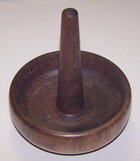
I'm just not turning much anymore, plus other jobs ( like cutting and splitting wood and stacking) like I just did, takes more out me than it used to do, have to be done, anyway thanks but no thanks
Last edited:


